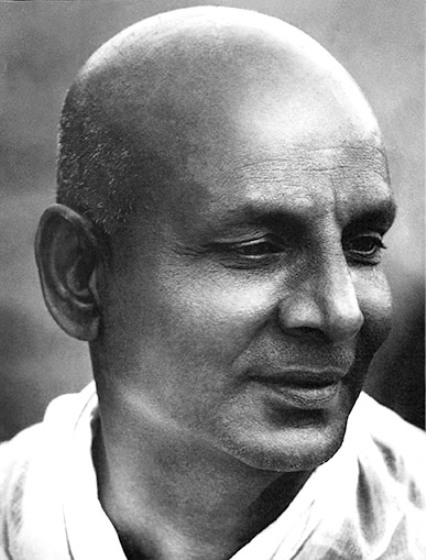Lives of the Masters Part 1 – Swami Sivananda (1887–1963) & Satchidananda Saraswati (1914–2002)
At Radiant Yoga we offer a diverse range of classes. You’re right, there’s a bewildering array of types of yoga to choose from, so we thought we’d like to provide our yogis and yoginis, plus anyone who is contemplating joining one of our friendly classes, with some information about the Yoga Masters who created the various schools ancient and modern. In this blog, we’re starting with Sivananda and Satchidananda Saraswati, two holy men who brought classical yoga to the West.
Biography
Sivananda was born in 1887 in a small village called Pattamadai in South India. As a boy he was gifted academically, but he was also very good at gymnastics and showed a natural leaning towards spiritual practices. His parents were devotees of Lord Siva/Shiva, one of the three main Hindu deities. Interestingly, one of his many names is Yogeshwara, or the Lord of Yoga.

Sivananda trained as a medical doctor although once he’d graduated, he felt a strong pull to travel to Malaysia where he ran a hospital and developed a reputation as a great humanitarian. During this time he treated a Sannyasin who taught him about Yoga and the Vedanta. This is the philosophical part of the ancient Indian scriptures known as The Vedas, and specifically refers to as the Upanishads. Following this encounter, Sivananda (then still known as Dr. Kuppuswami) travelled to Rishikesh in northern India where he took vows as a Sannyasin and became known as Swami Sivananda Saraswati.
He became one of the most prolific yoga teachers the world has known, even though he had only left Rishikesh twice during his life. Instead, his writings spread his teachings rapidly and he wrote more than 200 books on yoga and spiritual teachings. In 1957 he sent his disciple Swami Vishnudevananda to the West where he set up the International Sivananda Yoga Vedanta Centres.
Spiritual Instructions
Sivananda created 20 Spiritual Instructions to help every person live life to the fullest. The second spiritual instruction concerns yoga, and this is what Sivananda prescribes as a daily practice:
“Sit in Padmasana (lotus pose), Siddhasana (adept’s pose) or Sukhasana (any pose you like) for your Japa and meditate for half an hour, facing east or north. Increase the period gradually to three hours. Practice Sirshasana (headstand) and Sarvangasana (shoulderstand) for maintenance of health and Brahmacharya. Take light physical exercises such as walking, etc., regularly. Do twenty rounds of easy, comfortable Pranayama (breathing exercises). Do not strain yourself while doing Pranayama.”
The 5 Points of Yoga and 12 Basic Asanas
His disciple Swami Vishnudevananda condensed Sivananda’s teachings into 5 Points of Yoga
– Proper exercise
– Proper breathing
– Proper relaxation
– Proper diet
– Positive thinking & meditation
In yoga classes we focus on ‘Proper exercise & Proper breathing’ and in Sivananda’s teachings a class usually follows the 12 Basic Asanas. He teaches that you should always perform the Surya Namaskar (Sun Salutation) before the 12 asanas.
Technique
The technique used in this yoga is based on a slow pace, great attention given to proper breathing and on calming the mind while developing strength, flexibility and vitality in the body. If you go to a Sivananda Vedanta Centre class you’ll probably find that it will start with Pranayama (breathing) warm-ups that include the Sun Salutation, followed by a routine that works through the 12 asanas and ends with time given to deep relaxation.
Basically, Sivananda devised a form of yoga for practice at home or in a yoga studio class that synthesized the more formal teachings. It’s an integrated approach that provides the student with a ‘complete yoga’ for every part of life. For Sivananda, Yoga is never just about the asanas, and he is still considered one of the greatest Masters of this classical approach to yoga.
Satchidananda Saraswati
Sivananda’s legacy would also live on through the work of Swami Satchidananda who introduced many Westerners to yoga during the 1960s through his manual Integral Yoga Hatha.
Originally called Ramaswamy, Satchidananda found his guru—Sivananda—following a long spiritual and physical journey after the sudden death of his wife. The turning point for yoga in the West came when artist Peter Max invited Satchidananda to New York in 1966. He stayed on in the U.S. and was the opening speaker at Woodstock festival. He also founded the Integral Yoga Institute at his ashram Yogaville in Buckingham. Virginia.
The Essence of Integral Yoga
This approach to yoga focuses on restoring ease and peace to body and mind. Because, as Satchidananda said, “dis-ease is the disturbance of one’s natural ease.”
His Six Branches of Integral Yoga include:
– Hatha yoga – postures (asanas) and breathwork
– Raja yoga – meditation
– Bhakti yoga – cultivating love and devotion for God
– Karma yoga – acts of selfless service
– Jnana yoga – the path of reflection and self- enquiry
– Japa yoga – using mantra repetition during meditation
From the mid 60s, Hatha yoga practice grew in popularity among Westerners and its asanas and breathing technique became the ‘standard’ form for the majority of classes until new styles started to emerge. It is the form most used in traditional healthcare settings, where yoga is now more accepted as an excellent way to maintain good health, as well as ease specific issues.
Radiant Yoga Marbella offers a variety of yoga classes in our Marbella studio including, Hot Yoga (similar to Bikram yoga but with more varied sequencing), Vinyasa Yoga & Vinyasa Flwo Yoga, Anusara Yoga, Traditional Hatha Yoga and Kids Yoga.
Please keep an eye on our events page or join us on Facebook where you’ll find up-to-date information about our classes and workshops, plus other yoga information.

